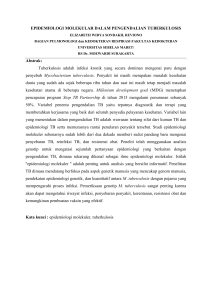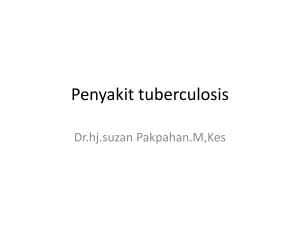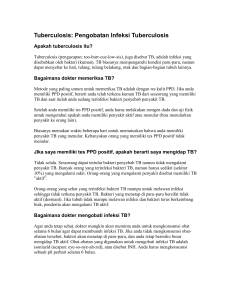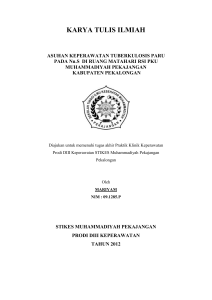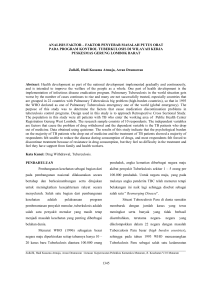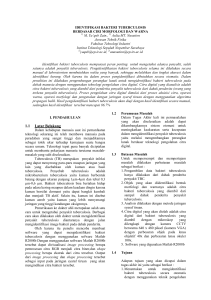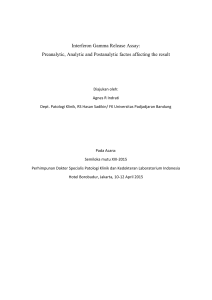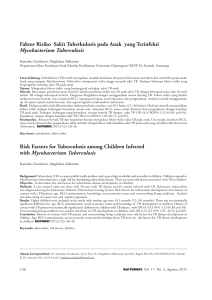Pengembangan Kandidat Vaksin Oral Berbasis Protein
advertisement
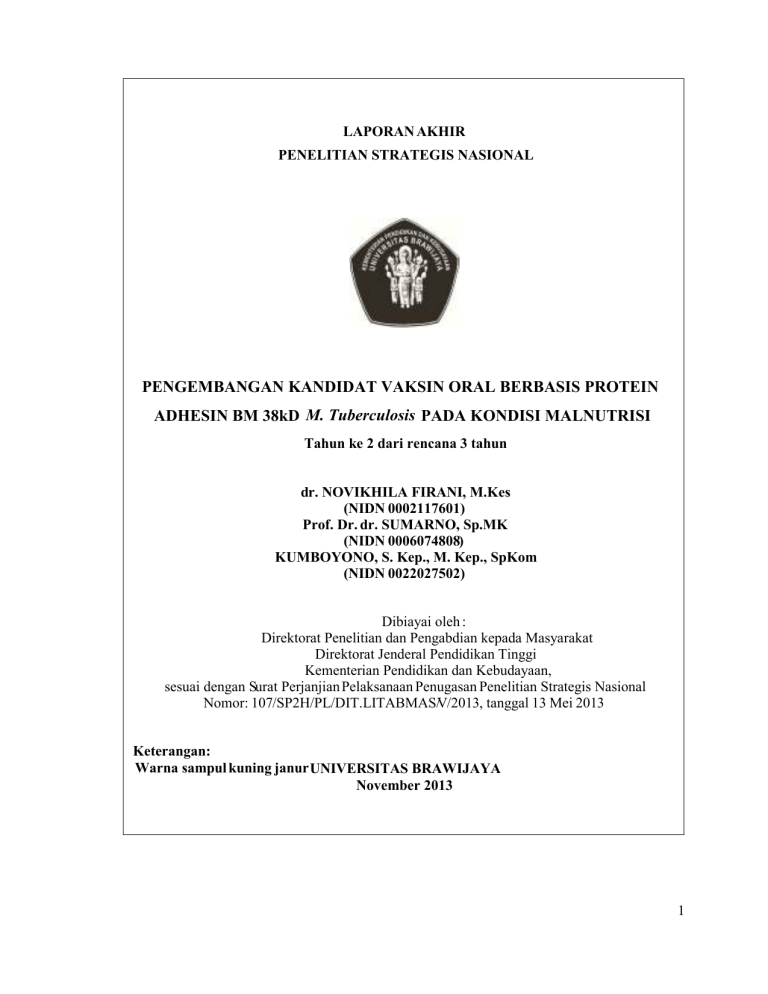
LAPORAN AKHIR PENELITIAN STRATEGIS NASIONAL PENGEMBANGAN KANDIDAT VAKSIN ORAL BERBASIS PROTEIN ADHESIN BM 38kD M. Tuberculosis PADA KONDISI MALNUTRISI Tahun ke 2 dari rencana 3 tahun dr. NOVIKHILA FIRANI, M.Kes (NIDN 0002117601) Prof. Dr. dr. SUMARNO, Sp.MK (NIDN 0006074808) KUMBOYONO, S. Kep., M. Kep., SpKom (NIDN 0022027502) Dibiayai oleh : Direktorat Penelitian dan Pengabdian kepada Masyarakat Direktorat Jenderal Pendidikan Tinggi Kementerian Pendidikan dan Kebudayaan, sesuai dengan Surat Perjanjian Pelaksanaan Penugasan Penelitian Strategis Nasional Nomor: 107/SP2H/PL/DIT.LITABMAS/V/2013, tanggal 13 Mei 2013 Keterangan: Warna sampul kuning janur UNIVERSITAS BRAWIJAYA November 2013 1 2 ABSTRAK Penyakit tuberkulosis (Tbc) yang disebabkan Mycobacterium tuberculosis merupakan penyebab utama morbiditas dan mortalitas di seluruh dunia, yang sering mengenai anak-anak dengan malnutrisi, khususnya defisiensi protein atau kwashiorkor. Pemerintah Indonesia sudah berupaya memberikan program vaksinasi BCG yang berasal dari M. bovis secara perkutan pada bayi untuk meningkatkan kekebalan terhadap infeksi M.tuberculosis, namun dilaporkan masih belum efektif. Pada proses perkembangan penyakit tuberkulosis, tahapan paling dini adalah perlekatan M. tuberculosis pada sel hospes. Penelitian sebelumnya berhasil mengidentifikasi protein adhesin berat molekul (BM) 38kD M. tuberculosis, yang bersifat imunogenik. Pada penelitian sebelumnya, mengukur respon imun seluler setelah pemberian imunisasi per oral protein adhesin 38kD M. tuberculosis, menunjukkan bahwa jumlah limfosit CD4 dan CD8 di intestinal dan pulmonal tikus dengan kondisi malnutrisi masih lebih rendah dibandingkan tikus dengan diit normal. Adanya penemuan ini menunjukkan bahwa pemberian protein adhesin 38kD M. tuberculosis belum mampu meningkatkan respon imun seluler di jaringan pulmonal dan intestinal. Diduga penurunan jumlah limfosit berhubungan dengan rendahnya asupan asam amino glutamin dalam diet akibat kondisi malnutrisi. Sel limfosit memerlukan glutamin, baik dalam kondisi istirahat maupun dalam kondisi teraktivasi oleh mitogen. Glutamin yang tidak adekuat bisa menghambat proliferasi limfosit yang akhirnya berdampak pada jumlah limfosit di dalam sirkulasi maupun di jaringan. Pada penelitian ini diberikan terapi glutamin disamping pemberian protein adhesin BM 38 kDa M. tuberculosis. Dari hasil penelitian menunjukkan induksi protein adhesin BM 38 kDa M.tuberculosis per oral disertai suplementasi glutamin bisa meningkatkan sistem imun seluler pada tikus model kwashiorkor, yang ditandai dengan peningkatan jumlah limfosit darah serta limfosit CD8 usus dan CD8 pulmonal. Kata kunci: diit rendah protein, imunisasi protein adhesin 38 kD M. tuberculosis, suplementasi glutamin, respon imun seluler 3 ABSTRACT Tuberculosis (TB ) caused by Mycobacterium tuberculosis is a major cause of morbidity and mortality throughout the world, who are often the children with malnutrition, especially protein deficiency or kwashiorkor. The Indonesian government has attempted to give the BCG vaccination program derived from M. bovis percutaneously in infants to increase immunity against M. tuberculosis infection, but reportedly have not been effective. In the process of the development of tuberculosis disease, the earliest stage is the attachment of M. tuberculosis in the host cell. Previous studies have identified adhesin protein molecular weight 38kD M. tuberculosis, which is immunogenic. In previous studies, measuring the cellular immune response after oral immunization 38kD adhesin protein of M. tuberculosis showed that the number of CD4 and CD8 lymphocytes in mice with intestinal and pulmonary conditions of malnutrition was lower than mice with a normal diet. This discovery suggests that administration of 38kD adhesin protein of M. tuberculosis has not been able to increase the cellular immune response in pulmonary and intestinal. The reduction in lymphocyte count was associated with lower intake of the amino acid glutamine in the diet due to the condition of malnutrition. The lymphocyte cells require glutamine, both at rest and under conditions activated by mitogen. Inadequate glutamine can inhibit lymphocyte proliferation that ultimately have an impact on the number of lymphocytes in the circulation and in tissues. In this study, glutamine therapy is given in addition to the immunization of 38 kDa adhesin protein of M. tuberculosis. The results showed that the induction of 38 kDa adhesin protein M. tuberculosis orally with glutamine supplementation can improve the cellular immune system in a rat model of kwashiorkor, which is characterized by an increased number of blood lymphocytes and CD8 lymphocyte intestinal and pulmonary CD8. Key words : low-protein diet, immunization adhesin protein 38 kD M. tuberculosis, glutamine supplementation, cellular immune response 4 RINGKASAN Kondisi malnutrisi seringkali disertai dengan kerentanan terhadap berbagai penyakit infeksi, khususnya penyakit tuberkulosis. Penyakit tuberkulosis yang disebabkan Mycobacterium tuberculosis (M. tuberculosis), sampai saat ini merupakanpenyebab utama morbiditas dan mortalitas di seluruh dunia, yang sering mengenai anak-anak dengan malnutrisi, khususnya defisiensi protein. Kasus tuberkulosis dan kematian yang masih tinggi mendorong penelitian dalam mengembangkan vaksin yang lebih sempurna untuk pencegahan penyakit tuberkulosis. Vaksinasi tuberkulosis yang telah lama digunakan adalah BacilleCalmette Guerin (BCG), merupakan mutan Mycobacterium bovis yang telah dilemahkan. Meskipun telah digunakan sejak lama, ternyata efektivitasnya masih diragukan, sehingga walaupun sudah divaksinasi anak tetap bisa sakit. Bakteri M. tuberculosis diketahui banyak mengandung substansi imunoreaktif, dan terbanyak terdapat di dinding sel. Pada proses perkembangan penyakit tuberkulosis, tahapan paling dini adalah perlekatan M. tuberculosis pada sel hospes. Perlekatan ini diakibatkan oleh faktor virulensi, yang diperantarai protein adhesin, terdapat pada permukaan dan pili bakteri. Penemuan terbaru menunjukkan adanya pengembangan vaksin yang berdasar pada molekul adhesin bakteri. Adhesin bakterial, yang dikombinasikan dengan ajuvan mukosal poten, merupakan pendekatan yang menjanjikan untuk vaksin mukosal. Penelitian sebelumnya berhasil mengidentifikasi protein adhesin berat molekul 38kDM.tuberculosis, dan mengukur respon imun seluler setelah pemberian imunisasi per oral protein adhesin 38kDM.tuberculosis. Hasil penelitian Firani, dkk (2012) pada tahun I menunjukkan bahwa jumlah limfosit CD4 intestinal dan pulmonal pada kelompok tikus dengan dit rendah protein lebih rendah dibandingkan kelompok tikus dengan diit normal. Jumlah limfosit CD8 pulmonal kelompok perlakuan tikus dengan diit rendah protein 4% tidak berbeda signifikan dibandingkan kelompok tikus diit normal, sedangkan kelompok tikus dengan diit 2% protein dan 0% protein lebih rendah jumlah limfosit CD8 pulmonal dibandingkan kelompok tikus dengan diit normal. Adanya penemuan ini menunjukkan bahwa pemberian protein adhesin 38kDM. tuberculosis belum mampu meningkatkan respon imun seluler di jaringan pulmonal dan intestinal. Diduga penurunan jumlah limfosit berhubungan dengan rendahnya asupan asam amino glutamin dalam diet akibat kondisi malnutrisi. 5 Menurut Linder (1992), penekanan imunitas seluler merupakan sesuatu yang khas ditemukan pada hampir semua penderita protein energi malnutrisi. Hal ini disebabkan karena pembentukan berbagai sistem imun dalam tubuh tergantung dari kemampuan tubuh untuk mensintesa protein. Sel limfosit memerlukan glutamin, baik dalam kondisi istirahat maupun dalam kondisi teraktivasi oleh mitogen (Kew, 1999). Glutamin yang tidak adekuat bisa menghambat proliferasi limfosit yang akhirnya berdampak pada jumlah limfosit di dalam sirkulasi maupun di jaringan. Dari penemuan tersebut dapat diduga bahwa tidak adekuatnya respon imun seluler setelah induksi protein adhesin 38 kDa M. tuberculosis disebabkan oleh kurangnya suplementasi glutamin, sehingga pada penelitian tahun II ini diberikan suplementasi glutamin disamping pemberian imunisasi per oral dengan protein adhesin 38 kDa M. tuberculosis. Dari penelitian ini diperoleh hasil kadar limfosit dalam darah pada tikus dengan diit normal yang diberi imunisasi per oral dengan protein adesin 38kDa M. tuberculosis per oral disertai suplementasi glutamin, rata-rata sebesar 77,1%, dan kadar limfosit dalam darah pada tikus dengan diit rendah protein 4%, 2% dan 0% berturut-turut adalah 76,9%, 75,05%, dan 70,5%. Berdasarkan data tersebut memperlihatkan bahwa kadar limfosit darah pada tikus dengan diit rendah protein yang diberi imunisasi per oral dengan protein adesin 38kDa M. tuberculosis per oral disertai suplementasi glutamin menunjukkan tidak adanya perbedaan yang signifikan dengan tikus dengan diit normal (p>0,05). Kadar limfosit CD8 dalam usus pada tikus dengan diit normal yang diberi imunisasi per oral dengan protein adesin 38kDa M. tuberculosis per oral disertai suplementasi glutamin, rata-rata sebesar 92,63%, dan kadar limfosit CD8 dalam usus pada tikus dengan diit rendah protein 4%, 2% dan 0% berturut-turut adalah 88,05%, 90,8%, dan 86,5%. Berdasarkan data tersebut memperlihatkan bahwa kadar limfosit CD8 dalam usus pada tikus dengan diit rendah protein yang diberi imunisasi per oral dengan protein adesin 38kDa M. tuberculosis per oral disertai suplementasi glutamin juga menunjukkan tidak adanya perbedaan yang signifikan dengan tikus dengan diit normal. Kadar limfosit CD8 dalam paru-paru pada tikus dengan diit normal yang diberi imunisasi per oral dengan protein adesin 38kDa M. tuberculosis per oral disertai suplementasi glutamin, rata-rata sebesar 89,17%, dan kadar limfosit CD8 dalam paru pada tikus dengan diit rendah protein 4%, 2% dan 0% berturut-turut adalah 84,97%, 83,18%, dan 86,7%. Berdasarkan data tersebut memperlihatkan bahwa kadar limfosit CD8 dalam paru pada tikus dengan diit rendah protein yang diberi imunisasi per oral dengan protein adesin 38kDa M. tuberculosis per oral disertai suplementasi glutamin juga menunjukkan tidak adanya perbedaan yang signifikan dengan tikus dengan diit normal. Maka hasil penelitian tahun ini menunjukkan bahwa induksi protein adhesin BM 38 kDa M.tuberculosis per oral disertai suplementasi glutamin bisa meningkatkan sistem imun 6 seluler pada tikus model kwashiorkor, yang ditandai dengan peningkatan jumlah limfosit darah serta limfosit CD8 usus dan CD8 pulmonal seperti pada tikus dengan diit normal. 7 SUMMARY Conditions of malnutrition, often accompanied by susceptibility to various infectious diseases, particularly tuberculosis. Tuberculosis, which is caused by Mycobacterium tuberculosis (M. tuberculosis), until now still a major cause of morbidity and mortality often the children with malnutrition throughout the world. Tuberculosis cases and deaths are still high to encourage research in developing a more perfect vaccine for the prevention of tuberculosis. Tuberculosis vaccination which has been used is BacilleCalmette Guerin (BCG), a mutant Mycobacterium bovis that was attenuated. Although it has been used for a long time, it turns its effectiveness is still in doubt, so despite having been vaccinated children still get sick. M. tuberculosis bacteria has been known to contain many immunoreactive substances, and most are in the cell walls. In the process of the development of tuberculosis disease, the earliest stage is the attachment of M. tuberculosis in the host cell. This is caused by the attachment of virulence factors, mediated by adhesin protein and pili on the surface of the bacteria. Recent findings indicate that the development of vaccines based on bacterial adhesin molecules. Bacterial adhesin, which is combined with a potent mucosal adjuvant, is a promising approach for mucosal vaccines. Previous studies have identified a protein adhesin 38kD M.tuberculosis and measure the cellular immune response after oral immunization 38kD M.tuberculosis adhesin protein. The results of the study Firani, et al (2012) in the first year showed that the number of CD4 lymphocytes in the intestinal and pulmonary groups of rats with low protein dit lower than the group of mice with a normal diet. The number of pulmonary CD8 lymphocytes treated group of mice with 4 % low protein diet did not differ significantly compared to normal diet group rats, while the rats with dietary 2% and 0 % protein have lower protein pulmonary CD8 lymphocyte counts compared with the diet group rats normal. This invention showed that administration of protein adhesin 38kD M. tuberculosis has not been able to increase the cellular immune response in pulmonary and intestinal tissues. The reduction in lymphocyte count may associated with lower intake of the amino acid glutamine in the diet due to the condition of malnutrition. According to Linder (1992), suppression of cellular immunity is typically found in virtually all patients with protein energy malnutrition. This is due to the formation of a variety of immune system in the body depends on the body's ability to synthesize protein. Lymphocyte cells require glutamine, both at rest and under conditions of mitogen-activated by (Kew, 1999). Inadequate glutamine can inhibit lymphocyte proliferation that ultimately have an impact on the number of lymphocytes in the circulation and in tissues. From these findings it can be presumed that an inadequate cellular immune response after induction of 38 kDa adhesin protein of M. tuberculosis 8 is caused by a lack of glutamine supplementation, making it the second year of this study are given glutamine supplementation in addition to oral immunization with 38 kDa adhesin protein of M. tuberculosis. From this study, the results showed that the average levels of lymphocytes in the blood of rats fed with normal diet orally immunized with 38kDa protein adesin M. tuberculosis orally and supplemented with glutamine , is 77.1 % , and the levels of lymphocytes in the blood of rats with a low-protein diet 4 % , 2 % and 0 % are 76.9 % , 75.05 % and 70.5 % respectively. Based on these data showed that the levels of blood lymphocytes in rats with a low protein diet fed orally immunized with 38kDa protein adesin M. tuberculosis accompanied by oral glutamine supplementation showed no significant difference with rats with normal diet (p > 0.05). The average levels of CD8 lymphocytes in the intestine in rats fed with normal diet immunized with 38kDa protein adesin M. tuberculosis orally and supplemented with glutamine, is 92.63 % , and the levels of CD8 lymphocytes in the intestine in rats with a low-protein diet 4 % , 2 % and 0 % are 88.05 % , 90.8 % , and 86.5 % respectively. Based on these data showed that the levels of CD8 lymphocytes in the intestine in mice with a low protein diet fed orally immunized with 38kDa protein adesin M. tuberculosis accompanied by oral glutamine supplementation also showed no significant difference with mice with normal diet. The average levels of CD8 lymphocytes in the lung of rats fed with normal diet immunized with 38kDa protein adesin M. tuberculosis orally and supplemented with glutamine, is 89.17 % , and the levels of CD8 lymphocytes in the lung of rats with a low-protein diet 4 % , 2 % and 0 % are 84.97 % , 83.18 % , and 86.7 % respectively. Based on these data showed that the levels of CD8 lymphocytes in the lung of rats fed a low-protein diet and given with oral immunization of adesin protein 38kDa M. tuberculosis accompanied by oral glutamine supplementation also showed no significant difference with rats with normal diet. The results of the study showed that the induction of adhesin protein 38 kDa M. tuberculosis accompanied by oral glutamine supplementation can improve the cellular immune system in a rats model of kwashiorkor, which is characterized by an increased number of blood lymphocytes and CD8 lymphocyte intestinal and lung CD8 as much as in rats with diet normal . 9 DAFTAR PUSTAKA Abbas, Lichtman, and Pober. 2000. Cellular and Molecular Immunology. Fourth Edition. W.B. Saunders Company, Philadelphia, London, New York. 348-351. Aditama, TY. 2003. Diagnosis of pulmonary tuberculosis. Simposium Nasional 2003: “Recent advances on TB and COPD”. Bandung, hal. 21 – 22. Birkness, et al. 1999. An in vitro tissue culture bilayer model to examine early events in Mycobacterium tuberculosis infection. Infect Immun, 67: 2, 653. Brandtzaeg P. 2003. Mucosal immunity in infectious http//:microbiology.utmb.edu. Accessted on 26 April 2003. disease and allergy. Brock, Madigan, Martinko, and Parker. 1994. The Biology of Microorganisms. Prentice-Hall, Inc., New Jersey, 532, 810. Buxton B. 2001. Interactions between Mycobacterium tuberculosis and the immune system. Davidson College. http://virtual.class.uconn.edu/~terry/Spring96/WebTB2/Groups/Group3/Final.html. Accessed on March 2006. Dannenberg and Tomashefski. 1998. Pathogenesis of Pulmonary Tuberculosis, in: Fishman et al. (Editors). Fishman's Pulmonary Diseases and Disorders. Third Edition. Vol 2. McGrawHill, New York, Toronto, Milan, pp. 2447-2451, 2454, 2462-2463, 2467. Doherty TM, Olsen AW, van Pinxteren L, and Andersen P. 2002. Oral vaccination with subunit vaccines protects against aerosol infection with Mycobacterium tuberculosis. Infect Immun. 70: 3111 , 3119. Dunlap et al. 2000. American Thoracic Society: Diagnostic Standards and Classification of Tuberculosis in Adults and Children. Am J Respir Crit Care Med. 161: 1376-1377. Ellner JJ. 1997. Review: The immune response in human tuberculosis—Implication for tuberculosis control. J Infect Dis. 176: 1351 – 1355. Feng et al. 1999. Increase in gamma interferon-secreting CD8+, as well as CD4+, T cells in lungs following aerosol infection with Mycobacterium tuberculosis. Infect Immun. 67: 7, 3242, 3245-6. Firani NK., Nesdyaningtyas E., 2012. The Lymphocytes Number in The Blood of Kwashiorkor Rat Model Induced by Oral Immunization with 38-kDa Mycobacterium tuberculosis Protein. Waset. Issue 69. September 2012.p164-6. Garay SM. 2004. Chapter 25 : Pulmonary Tuberculosis. In: Tuberculosis. Second edition. Rom WN, Garay SM and Bloom BR. Lippincott Williams & Wilkins. Philadelphi, New York, Sydney. 345 – 346. Goldsby, Kindt, and Osborne. 2000. Kuby Immunology. Fourth Edition, W.H. Freeman and Company, New York. 436-437. Harlow E and Lane D, 1989. Antibodies : A. Laboratory Manual, Cold Spring Harbor Laboratory, USA : 61,150,309,564,597 Jagirdar J and Zagzag D. 2004. Chapter 24: Pathology and Insight into Pathogenesis of Tuberculosis. In: Tuberculosis. Second edition. Rom WN, Garay SM and Bloom BR. Lippincott Williams & Wilkins. Philadelphi, New York, Sydney. 323. Janeway, Travers, Walport, and Capra. 1999. Immunobiology: The Immune System in Health and Disease. Fourth Edition, CB Publications, Garland Publishing, New York. 24, 302-303. 10 Jawetz E., Melnick JL., and Adelberg EA. 1998. Review of medical Microbiology. Lange Medical Publication. 278 – 279. Joklik et al. (Editors). 1992. Zinsser Microbiology. 20th ed. Prentice-Hall International Inc. 498499, 502-503. Liang X, Lamn ME, Nedrud JG, 1989. Cholera Toxin as Mucosal Adjuvant – Glutaraldehyde treatment dissociates adjuvanticity from toxicity., The Journal of Immunology, American Association of Immunologist, USA, 143 (2) : 484-490. Lietman and Blower. 1999. Science’s Compass: Tuberculosis vaccines. Science. 286: 1300. Male et al. 1996. Advanced Immunology, Mosby, London, Boston, New York. 10.12, 16.2. Murray, RK. 2001.Biokimia Harper edisi 25,Jakarta,EGC. Nicoletti C. 2000. Unsolved mysteries of intestinal M cells. Gut. 47: 735 – 737. Ogra PL, Faden H, and Welliver RC. 2001. Vaccination strategies for mucosal immune responses. Clin Microbiol Rev. 14 (2): 432 – 433, 437 – 438. Orme, Ian. 1995. Medical Intelligence Unit: Immunity to Mycobacteria, Springer-Verlag, New York, London, R.G. Landes Company, Austin. Porter JDH and McAdam PWJ. 1994. The re-emergence of tuberculosis. Annu Rev Public Health. 15: 314. Rambukkana et al., 1998. Role of -dystroglycan as a schwann cell receptor for Mycobacterium leprae. Science. 282. Rundless, 2002 Rundless, S.C. Effects of Nutritional Status on Immunological Function. Am.J.Clin.Nutr, 1202-1210 Schluger and Rom. 1998. The Host Immune Response to Tuberculosis. Am J Respir Crit Care Med. 157: 679-691. Scrimshaw dan Sangiovanni. Synergism of Nutrition, Infection, and Immunity: an Overview. Am.J.Clin.Nutr,1997 ; 66:464s-77s Subandi, Wihastuti, T.A., Firani, N.K., Tandya, S., Soemarno, 2009. Kadar S-IgA Bronkiolus pada tikus model kwashiorkor yang diinduksi protein adhesin BM 38kD M. tuberculosis. Jurnal Ilmu Hayati. Universitas Brawijaya. Tandya, S., 2006. Peran Protein Adhesin Mycobacterium tuberculosis dalam menginduksi Secretory Imunoglobulin A (S-Ig A) Mukosa usus dan Bronkhiolus Mencit Balb/c. Disertasi. Ulrichs T and Kaufmann SHE. 2002. Mycobacterial Persistence and Immunity. Frontiers in Bioscience 7: d458-469. van Ginkel FW, Nguyen HH, and McGhee JR. 2000. Attenuated viral vaccine for mucosal immunity to combat emerging infectious diseases. Emerg Infect Dis. 6(2) Centers for Disease Control and Prevention (CDC). Winarsih, Sumarno, dan Roekistiningsih. 1998. Fungsi dan sifat immunogenitas protein hemaglutinin 32 kD dan 20 kD pada Helicobacter pylori. Majalah Kedokteran Unibraw Malang. 13:135-141. Wizemann TM, Adamou JE, and Langermann S. 1999. Adhesins as a targets for vaccine development. Emerg Infect Dis. 5 (3): 396 – 398. 11 Zumla A and Grange J. 1998. Science, medicine, and the future: Tuberculosis. BMJ. 316 : 1962, 1963 , 1964 , MKep, SpKom 12

